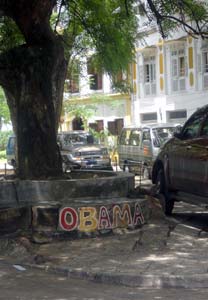|
An elderly African, in remote Tanzania, asks two travelers where they’re from.
“U.S.A.... America,” they reply.
The man seems to not understand, or maybe he just can’t hear them well.
“Barack Obama is my president,” says one of the travelers, louder.
“Barack Obama is my big boss,” jokes the other.
The elderly man is instantly electrified. He reaches out his hand in greeting. “Barack Obama is my brother.”
Sounds corny, but this really happened, recently.
 Whatever his troubles at home, internationally, U.S. President Barack Obama remains well-regarded, and in East Africa he’s more like a rock star. No longer quite the super-nova he was in November 08, but still a rock star. This ‘son of Africa,’ as he is sometimes called there, is a source of pride, fascination – and merchandise. You can see his name on everything from T-shirts to sandals , and linked to even the unlikeliest of venues: Obama Hair and Beauty. Obama Disco Club. Obama Expert Tayloring. Whatever his troubles at home, internationally, U.S. President Barack Obama remains well-regarded, and in East Africa he’s more like a rock star. No longer quite the super-nova he was in November 08, but still a rock star. This ‘son of Africa,’ as he is sometimes called there, is a source of pride, fascination – and merchandise. You can see his name on everything from T-shirts to sandals , and linked to even the unlikeliest of venues: Obama Hair and Beauty. Obama Disco Club. Obama Expert Tayloring.
President Obama’s links to Africa gave Africans not only a huge emotional boost – but a significant tourism boost as well. In fact, in the year following Barack Obama’s election, Africa was the only continent reporting a rise in international visits. Everyone else was down due to the global recession and concerns over the outbreak of swine flu. Kenya in particular experienced a boom in so-called “roots tourism” by African Americans interested in exploring the world of Obama’s father, who grew up in western part of the country. That, plus the growing popularity of DNA testing to help identify African Americans’ ancestral origin, resulted in record numbers of U.S. citizens traveling to Africa. Even Ghana saw a steady increase in tourism to its Cape Coast Castle, a prominent former slave trade fort, after the President was photographed there on a trip with his daughters in 2009.
So if you’re contemplating a trip to Africa, don’t put it off. There’s probably never been a better time for Americans to discover this magnificent continent. And when you get there, odds are, you’ll be warmly welcomed by gracious people who also just happen to love your President. Enjoy. That hasn’t been the case for quite a while.
By Kevin O'Neill
|